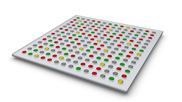
microarray

A microarray is a laboratory tool used to detect the expression of thousands of genes at the same time. DNA microarrays are microscope slides that are printed with thousands of tiny spots in defined positions, with each spot containing a known DNA sequence or gene. Often, these slides are referred to as gene chips or DNA chips. The DNA molecules attached to each slide act as probes to detect gene expression, which is also known as the transcriptome or the set of messenger RNA (mRNA) transcripts expressed by a group of genes.
To perform a microarray analysis, mRNA molecules are typically collected from both an experimental sample and a reference sample. For example, the reference sample could be collected from a healthy individual, and the experimental sample could be collected from an individual with a disease like cancer. The two mRNA samples are then converted into complementary DNA (cDNA), and each sample is labeled with a fluorescent probe of a different color. For instance, the experimental cDNA sample may be labeled with a red fluorescent dye, whereas the reference cDNA may be labeled with a green fluorescent dye. The two samples are then mixed together and allowed to bind to the microarray slide. The process in which the cDNA molecules bind to the DNA probes on the slide is called hybridization. Following hybridization, the microarray is scanned to measure the expression of each gene printed on the slide. If the expression of a particular gene is higher in the experimental sample than in the reference sample, then the corresponding spot on the microarray appears red. In contrast, if the expression in the experimental sample is lower than in the reference sample, then the spot appears green. Finally, if there is equal expression in the two samples, then the spot appears yellow. The data gathered through microarrays can be used to create gene expression profiles, which show simultaneous changes in the expression of many genes in response to a particular condition or treatment.
Further Exploration
Concept Links for further exploration
















